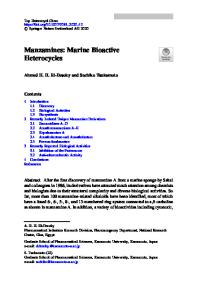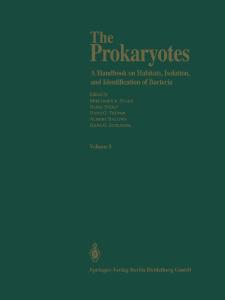Bioactive Substances from Marine Cyanobacteria
Marine cyanobacteria have been known as prolific producers of secondary metabolites that have intriguing structures and remarkable biological activities. In fact, some of them have been regarded as promising candidates for drugs and have attracted attenti
- PDF / 701,946 Bytes
- 19 Pages / 439.37 x 666.142 pts Page_size
- 21 Downloads / 314 Views
Bioactive Substances from Marine Cyanobacteria Kiyotake Suenaga and Arihiro Iwasaki
Contents 1 Introduction 2 Polyketides and Macrolides 2.1 Biselyngbyasides 2.2 Koshikalide 2.3 Leptolyngbyolides 2.4 Kanamienamide 2.5 Hoshinolactam 2.6 Yoshinone A 2.7 Caldorin 3 Linear Peptides with Heterocycles 3.1 Bisebromoamides 3.2 Biseokeaniamides 4 Linear Peptides and Depsipeptides 4.1 Maedamide 4.2 Izenamides 4.3 Iheyamides 5 Lipopeptides 5.1 Kurahynes 5.2 Jahanyne Family 5.3 Hoshinoamides 5.4 Minnamide A 5.5 Mabuniamide 5.6 Ikoamide 6 Cyclic Peptides and Depsipeptides 6.1 Kurahamide 6.2 Janadolide 6.3 Urumamide 6.4 Kohamamides 6.5 Croissamide 7 Conclusion References K. Suenaga (*) and A. Iwasaki Department of Chemistry, Faculty of Science and Technology, Keio University, Yokohama, Japan e-mail: [email protected]
K. Suenaga and A. Iwasaki
Abstract Marine cyanobacteria have been known as prolific producers of secondary metabolites that have intriguing structures and remarkable biological activities. In fact, some of them have been regarded as promising candidates for drugs and have attracted attention from pharmaceutical companies. For the last 14 years, our group has investigated the secondary metabolites of marine cyanobacteria collected in Japanese coastal areas and has discovered more than twenty types of new natural products from them. In addition, we have evaluated the biological activities of these compounds and have clarified the mode of action of some of them. Also, we have achieved the total syntheses of several of these compounds. In this review, we summarize our efforts regarding the novel natural products that we have discovered so far. Keywords Biological activity · Marine cyanobacteria · Marine natural products · Structure elucidation · Total synthesis
1 Introduction The chemical studies of bioactive natural products are important not only in the field of chemistry but also in a wide range of related fields such as medicinal and pharmaceutical sciences. Marine organisms such as microorganisms, algae, sponges, tunicates, and mollusks have attracted considerable attention as a rich source of new bioactive substances, and a large number of bioactive substances have been found from them [1]. Among marine organisms, marine cyanobacteria have been considered as a treasure trove of bioactive substances. Cyanobacteria (sometimes called blue-green algae) are a group of bacteria that perform oxygen-producing photosynthesis. They are very old organisms that have existed on Earth for about 3 billion years. They have been greatly involved in the formation of the Earth’s atmosphere, the evolution of life, and the supply of organic substances on a global scale. The secondary metabolites produced by cyanobacteria are often peptides or peptidepolyketide hybrids, and many of the peptides are highly N-methylated. In this review, we describe that our studies on isolation, structure determination, total syntheses, and biological activities of natural products isolated from marine cyanobacteria collected mainly at Okinawa and
Data Loading...











